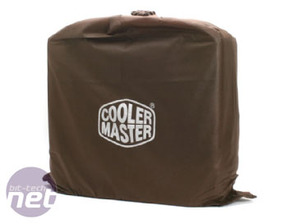
Cooler Master Cosmos S
Manufacturer: Cooler MasterUK Price (as reviewed): £150 (inc. VAT) (MSRP)
US Price (as reviewed): TBC
The Cooler Master Cosmos and bit-tech go way back. Together we’ve crossed entire oceans of history – whopping deserts of emotion. We were there when the Cosmos was first launched and we were one of the first to review the rather impressive case too. Hell, we even followed the case in the run up to its release when it was first spotted out at CeBIT last year.
Now, we can watch as it takes a bow and edges back out of the limelight a little, allowing room for its new sibling, the Cosmos S.
The Cosmos S is the bigger, better brother of the original Cosmos RC-1000 and has a whole host of new features – a swanky touch sensitive button, a tweaked cooling system and a new bezel.
Importantly, Cooler Master has taken away just as much as has been added on and hasn’t been afraid to do away with some of the more striking aspects of the original’s design. Those big foam sheets on the inside of the side panels on the original Cosmos are now but a distant memory and by removing them Cooler Master has freed up more space inside the case.
So, there’s plenty to be excited about with the new Cosmos S and at around 25 percent more than its predecessor in money-terms this aluminium monster could prove to be quite a good buy too – all the more reason to keep reading our review.
King of All Cosmos…S
There’s a lot more goes into one of these reviews than you think, y’know. There’s testing, photography, complaints about fingerprints, cleaning, more photography and unboxing. It’s a tough job and, with the Cosmos S at least, even the unboxing was challenging.The Cosmos S turned up on our doorsteps courtesy of Cooler Master in a thoroughly standard looking cardboard box. Quickly, Tim, Richard and I gathered round the box and, whipping out our trusty penknives (they’re for protection, guv – Ed.), descended on the feeble card. In a matter of seconds we had the case out – or so we thought. What we actually had was a case in a polystyrene shell.
Sure, nothing wrong there – most good manufacturers use that method to protect their products from damage. Good job Cooler Master, we said, as we chiselled off the polystyrene tomb and revealed the case underneath. Except there was no case underneath – there was a massive cloth bag bearing the Cooler Master logo.
Soon enough we undid the third layer, placed Richard inside the bag and looked once more at the case... through a fourth layer of plastic sheeting. The plastic sheeting was promptly removed – but that too only revealed layers of plastic stuck all over the details and foam tubes covering the handles (underneath which there were layers of adhesive plastic).
It seems weird that Cooler Master would go to such lengths to disguise and hide the Cosmos S’ features anyway because, once you’ve tunnelled through the maze of packing techniques like a rabbit with its ass on fire, the Cosmos S is actually a very nice case. Very nice.
The overall aesthetic is still akin to the first Cosmos, with two huge handles on the top and the bottom. These handles are made from metal though, so a quick word of advice; make sure you ground yourself when you touch them. After wading through all the plastic sheeting and polystyrene, we got more than our fair share of electric shocks when we went to pick up the then-naked Cosmos S.
On the exterior though there have still been a few enhancements and changes. The left side panel, which was previously blank and pristine, is now a grilled window hiding a huge 200mm fan. The door of the Cosmos has been done away with as well, leaving just a plain and straightforward set of drive bays.
The top of the case has changed too and the Cosmos S gives by far and away the best results on the Martin Test that we’ve ever seen. It is cheating a little though – the Martin Test, which tests the rattle of the power button as an indicator of overall build quality, isn’t especially valid here as the power button is actually a touch sensitive recess in the top of the case. Hidden on the top panel is a sliding cover that moves back to reveal an extended set of ports over the Cosmos.

MSI MPG Velox 100R Chassis Review
October 14 2021 | 15:04












Want to comment? Please log in.